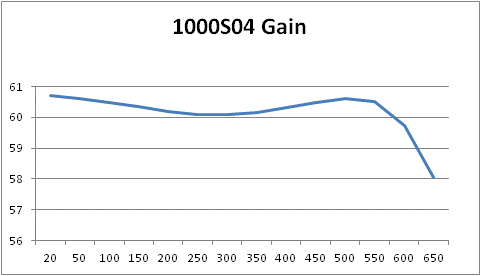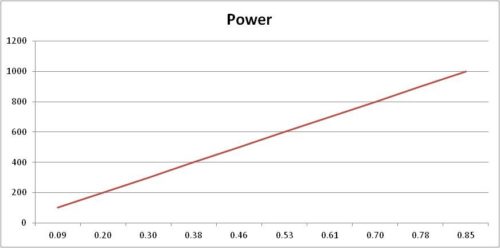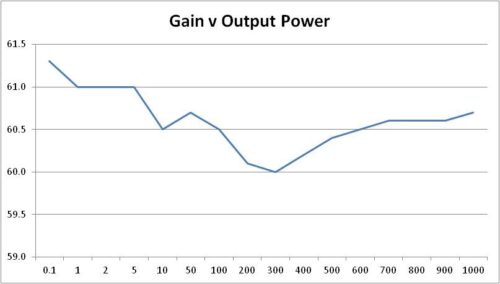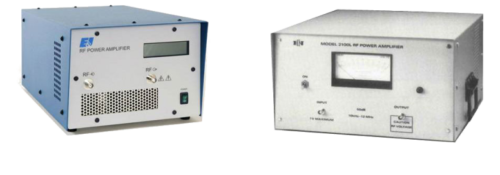Category Archive: Uncategorized
The Secret of the S-Series
Written by Tony Harris, 2nd September 2017
Someone was asking me the other day; how we are able to get such high switching rates on the large Fets that we use in our S-Series to enable us to achieve 1000 watts over a 600 KHz bandwidth. It is a good question, if you look at the performance of linearity, bandwidth and flatness you think that we were switching at over 3 MHz. Actually, in the 1000S04 we only switch at 1.6 MHz. But, then we use the technique, common in switch mode power supply design, to interleave the two halves of the H bridge. This enables us to mimic the performance that one would expect by from switching at 3.2 MHz.

KHz
So that’s the secret. We are looking to interleave in quadrature and so further push the frequency while maintain the excellent linearity and harmonic performance.


Old Documents
Written by Tony Harris, February 8, 2017
The value of note taking and retention of documents is severely reduced if one is unable to locate the information at a later date. We are lazy these days, I fear. With the advent of “search” applications we just type a few words into our PC and hit enter. Seemingly, miraculously, relevant documents are unearthed. And so our filing systems have become all but redundant. I have pieces of paper that collect upon my desk and when they have reached an amount that I find annoying, I file them. I do this by sorting them into two groups. The first I unceremoniously dump into the shredder, and the second I simply stuff into a manila folder – mark it “Important and Confidential” and shove it into a filing cabinet in my office. This works very well for the retention of documents. But it leaves a lot to be desired with respect to the retrieval aspect and so calls into question the value of the whole activity in the first place. Of course, as I file said documents, I am convinced that I shall remember where they are. But then in actuality, when I try to find something, the fact that I know of their existence only increases my frustration. I get incensed as I randomly and fruitlessly pull out filing drawers, folders and documents and then vacillate between the scanning and perusal of page after page.
But I did take refuge in the belief that this was a universal problem with varying solutions all based on the effort and time that one puts into maintaining a system. Jan, my wife, for example files all the required documents for taxes, insurance, appliance operating manuals and is able to locate them as required. Although I do not have the necessary skill set to perform this task, it is a fairly simple set theory problem, with well defined labels.
The other day, I was asked a question by a customer in Australia as to the IMD performance of E&I amplifiers with 12 tones at 2 watts per channel. I was fairly sure that I did not have any information on how to glean this data from our test records and after a quick Google search left me empty-handed I decided to ask Serge Juhel, an old colleague of mine for help. I say old colleague as I have known him for a long time and he is old. Serge came to the rescue with the calculation of PEP and the recommended CW power required. In addition to attaching a document delineating the test procedure, he also copied an old colleague of ours, John Pritiskutch (yes; we’ve known him for a long time and he’s old) and asked him to verify the calculations and check the formulae. John kindly did this but noted his surprise that we were having this discussion as Serge had previously authored a document which I was copied on, that explains the calculations in detail. John had thoughtfully attached a copy of this document to his e-mail.
The document that John attached was a scan of a print out of an e-mail that Serge had sent me in 1992.
This is 2017! What sort of archival system does John have? The question was about multi-tone IMD performance v two-tone measurement. What can you file that under and be able to retrieve it??? Remember, this is a paper system. The document he sent me was scan of a print out. The print out was from a “dot matrix’ printer!
So in conclusion; I’d say, if you are looking for the answer to an RF question ask Serge Juhel; he probably can answer it without looking for notes. Or ask John Pritiskutch, he also can probably answer without looking for notes, but if he needs to – he has them!
E&I OEM Solutions
Written by Tony Harris, November 17, 2016
Anyone involved in RF design or testing in the field of ultrasound, telemetry activation, HF, VHF or UHF applications knows E&I®. Over the last 13 years, picking up where ENI® left off, we have been supplying the industry with rugged and reliable broadband power amplifiers.
They will not be the lightest piece of test equipment on your bench, nor indeed the quietest. They will probably be your bluest and also the most rugged and reliable piece of gear. They are indeed known throughout the industry as the stalwart solution for your RF testing needs.
About six years ago, at the behest of several customers, we began supplying RF modules. This enabled our customers to utilize our superior technology and proven designs as an integral part of their systems. Working with these customers we have found that to in order to provide the optimum RF solution, it preferable to begin working with them, as an extension of their design team, early on in the OEM project.
We have therefore launched a new division; called the E&I OEM Solutions Division. The charter of this new group is to work with clients to define their RF needs and assist in architecting the clients system, to bring the RF issues to the forefront and so avoid wasted time and effort in unnecessary design cycles. Then, utilizing the technology and expertise of E&I’s engineering group provide an optimum OEM solution.
To learn more about E&I’s OEM Solutions Division and how you can utilize the group as an extension of your design team, give me a call or drop me an e-mail.
Cheers,
Tony Harris (November 17, 2016)
E&I’s New S Series RF Amplifiers
Written by Tony Harris, August 25, 2016
You may have heard of Class D RF amplifiers, you may have heard of Class S RF amplifiers and you may have heard differing definitions of both. There seems to be a lot of confusion on the subject. Depending upon whether you come from the audio world or the RF world you will probably hold opposing views of which is correct.
Far be it from me to get embroiled in such a messy discussion. E&I is launching a series of amplifiers, some that operate in Class D and some that operate in Class S. But we’re not saying which is which to avoid getting ensconced in the argument and having pocket protectors thrown at us.
So there are two types of amplifiers; one is a ‘Sampling’ type, that can be broadband and can operate from DC up to about 1/5th of the Nyquist frequency and the other is a ‘Switching’ amplifier that is narrow band and operates at the switching frequency. So we call them our S-Series of amplifiers and dodge the all important question.
We are fortunate that our lead design engineer on the project, Bill Pulhamus, has that all important combination of talent and experience. What is exciting is that using this technology he has been able to keep the integrity of Class A performance and yet achieve 90% efficiency. This means that we are able to produce an amplifier that is much smaller and at a much lower cost.
The first one of our S-Series to go into production is of the ‘Sampling’ type which means that it also offers wide bandwidth. It produces 1,000 watts from 20 – 200 KHz and is in a 2U rack mount form factor. We will be releasing further models later in the year as we push the frequency up.
Tony Harris
August 2016
Mass Spectrometry
Written by Tony Harris, August 18, 2016
Spectrum: The word is derived from the Latin word to look and was used describe an image or ghost. The word spectrum was first used, by Isaac Newton, in the field of optics to refer to the output of a prism. Such as the one depicted on Pink Floyd’s “Dark Side of The Moon” album. Good album that, alas I digress. Soon the term expanded to apply to other waves that could be measured as a function of frequency. For example sound waves and all types of electromagnetic waves. It later became used to describe any continuum.
So when we talk about spectral analysis we are referring to a measurement of some function along a continuous variable. A spectral analysis of a rainbow for example would consider the intensity of light as a function of the colors present. If we did a spectral analysis of someone’s speech we would find that certain frequencies were more common than others.
Mass Spectrometry is name given to a technique that allows us to identify materials by analyzing their mass to charge ratio. Mass spectrometry was invented at the University of Birmingham by Francis Aston. He received the Nobel Prize in Chemistry for his invention in 1922. My father worked on the mass spectrometer at the University of Birmingham in the mid-1940’s but he didn’t get a Nobel Prize.
In its simplest form a mass spectrometer uses an electric field to accelerate ions and then uses a magnetic field to deflect them. Depending upon the ratio of the electric charge to the mass, the ions will be separated and so can be identified by their mass/charge ratio. One type of mass analyzer used in mass spectrometry is a quadrupole. Here an RF (radio frequency) signal is applied to four conductors. As the ions travel through the quadrupole the electric field set up by the RF signal will cause ions with a specific mass/ charge ratio to reach the detector.
Matt Brantley of Baylor University presented a poster at the ARMS conference in San Antonio, Texas earlier this year entitled: A Modular Data Station for Radio-Frequency Ionization FT-ICR Mass Spectrometry Imaging. We were pleased to work with Matt on the Amplifier and balun circuitry for his quadrupole. These studies facilitate metabolomics, the understanding of metabolism and the drugs that can help support it. We are excited to be part of this research.
Tony Harris August 2016
Metabolomics: Have doctors lost their bedside manner?
Written by Tony Harris, August 11, 2016
Have doctors lost their bedside manner?
The appropriate bedside manner is actually addressed in the Hippocratic Oath. The original version went on to state that ‘Gravity signifies breadth of experience’. Of course without all the drugs and remedies available today, there was little else that doctors could offer, other than a bedside manner. Do not misunderstand me, I am not in any way attempting to belittle the Hippocratic Oath with respect to its importance then or today. I’m just saying they didn’t really have any good drugs back then!
Have you ever wondered how all the drugs that doctors have at their disposal today were discovered? In 1928 Alexander Fleming discovered penicillin; by his own admission, it was in part serendipitous. Certainly we can’t sit around and wait for mold to grow in the hope that another new medicinal cure materializes. Likewise we can’t just shove chemicals in sick people to see if there is anything that makes them better.
You’ll be glad to hear that we do have a scientific approach. It is called metabolomics. Metabolomics is the study of cell metabolism or more accurately the study of metabolites which are the products of metabolism. So what the heck does all that mean anyway? Let’s start with metabolism; it is just a fancy word used to describe the chemical reactions involved in maintaining the living state of the cells and the organism. So; you and me for example! As the chemical reactions take place, keeping you and me alive, there are products and by-products of these reactions. These are called metabolites.
The color, smell and even, unfortunately, taste of urine has been used to detect certain medical conditions since the Middle Ages and before. Urine is a rich source of metabolites, but it was not until the 1970’s that the analysis tools really started to come into their own. It was then they could become looked upon as a chemical fingerprint. So if we see the presence of a particular metabolite in a sample, we can use that as evidence to diagnose a condition in the patient.
The study of metabolomics and analysis of metabolites are increasingly being used to diagnose disease, understand the underlying mechanisms of disease and to identify novel drug targets. This leads to customized drug treatments.
In 2005 the first database of metabolites was founded at the Scripps Institute in San Diego with 10,000 metabolites and the associated mass spectral data. My nephew, Dr. H. Paul Benton, of the institute tells me that today, there are over 240,000 mass spectrometry signatures of metabolites in their database.
This certainly opens up avenues to enable us to further our understanding of disease and to formulate drugs to target said disease.
So have doctors lost their bedside manner and is it relevant anyway today? I am not sure. One does feel, however, that even with a collection of snake oils at the ready, a little empathy would not have gone amiss on Hugh Laurie’s character, Dr. House.
Tony Harris
August 2016
Those That Can…
Written by Tony Harris, July 22, 2016
Those that can, do. Those that can’t, teach!
That was something that someone repeated to me, I thought funny; in my youth.
But now as I sit here, with seven and fifty years behind me, I realize that I owe a great deal to my teachers. Mrs. Fenton, Mrs. Barbie, Mrs. King, Mrs. Debetencourt, Mr. McCarthy, Brother Joseph, Mary Conway, Kevin Conway… I could go on and on.
It really is a debt that I can never repay.
Kevin Conway taught me to be curious in physics class by challenging me to answer my own questions and then to question my own answers.
Mary Conway taught me to love reading and literature. I can still today recite “An Irish Airman foresees his death” by W. B. Yeats. I can quote a little Shakespeare, Austen and Dickens. Oh, did she get angry with me when she came back from maternity leave and found out I had not finished “Great Expectations”. I read it from front cover to back cover the following weekend.
Brother Joseph wasn’t able to teach me French. I shudder as I recall how I made him cry. An embodiment of the petulance, arrogance and ignorance of youth, was I. So he did eventually teach me humility.
Mr. McCarthy however, had no time for my antics. “The dog ate my homework” would not fly with him. But he would save me the embarrassment of having to reveal my spelling score to the class, a great teacher – true class.
Mrs. Debentencourt showed me how you can make words jump off a page. She explained how the word “nice” was meaningless, today she would say the same about “awesome”. She taught me to use less common words and maybe even to use a word that doesn’t quite fit; stretch it, pull it, make your reader think.
Mrs. King oh-she was a no nonsense teacher. Put the fear of God in anyone of us. A clip around the ear, a smack upside the head, but she was a superb teacher. She showed me how mathematics made sense, how to transfer numbers from one base to another.
Mrs. Barbie was my fourth grade teacher and gave me the confidence to speak in front of the class.
Mrs. Fenton taught me my 7 times table. I had trouble with that.
So really teachers do a lot more than those of us that ‘do’, they enable lots of people to ‘do’. They shine a light so we can see, give us the tools to forge a path and help us understand the direction we want to go.
If you are lucky, you will still have a teacher no matter how old you are. I have one. She pushes me, pulls me, guides me, she shines a light so bright such that I can see to find my direction in the wilderness and provides me with the tools to forge my path. If you don’t have one, you should get the same one as me: Bobbie Goheen.
Open Source
Written by Tony Harris, June 14, 2016
When we talk about ‘open source’ we are usually referring to software where the source code is made available to the users which allow them to modify or change the code. But recently, it has been used to describe systems where the details are made available in their entirety.
Researchers at Vanderbilt University have recently released details of an open source HIFU system along with a parts list. The system incorporates the E&I A150 RF Amplifier. Charles Caskey, Ph.D., and Will Grissom, Ph.D., of the university’s Institute of Imaging Science (UIIS) addressed the issue that they believe has been slowing down the development of HIFU research.
It is hoped that this system will allow comparable results across research organizations and institutions.
Tony Harris
June 2016.
E&I v ENI
Written by Tony Harris, March 4, 2016

What is the difference between ‘Electronics & Innovation’ and ‘Electronic Navigation Industries’? The last ENI® broadband amplifier rolled off the production line in 2000 after, a proud, 31 years of design and manufacturing. The last E&I® amplifier rolled off the production line about 15 minutes ago and another will shortly follow. A proud 13 years of design and manufacturing, to date. I am confident that E&I® will be around for another 30 years, although I personally by then may have cocked my toes or at least hung up my soldering iron, slide rule and napkin!
Over 31 years ENI® made a name for producing rugged and reliable RF power amplifiers. In fact we still get them back here to service, often 30 years old and Jeff Kopalek, our service manager, breathes a new lease of life into them.
With the E&I® amplifiers, our customers experience the same rugged and reliable performance that they have come to expect, the same conservative ratings and unparalleled customer support. Most of the new amplifiers have a four-port coupler on the output. This enables us to measure forward and reflected power, which is displayed on the front panel and can also be accessed via an RS232 connector on the rear panel. The RF sections use DMoS or LDMoS devices de-rated to the same guidelines that we used at ENI® and the AC sections employ modern switch mode power supplies.
So if you are looking to replace an ENI amplifier, look no further than here. If you are looking for a new application, this frequency power chart is very useful. But better still contact us, give us a call or drop us a line. We would love to discuss your application with you.
Cheers,
Tony Harris
Nano Tubes
Written by: Tony Harris, February 25, 2016
One of the things I learned at university was how to research a subject. How to go into a library and find the information I needed, traversing the Dewey Decimal System as I went. If I got really stuck I’d dip into an encyclopedia, but this only as a last resort. In the world of Britannica or Americana, it is too easy to get lost. Something catches your eye and you wander down one path to another and suddenly it seems that you are a character in a Brothers Grimm story. Hours have passed, you don’t know how you got to where you are and the pubs are about to close! Which reminds me of the other thing I learned at university; alas, I digress.
We are working with a scientist at Rice University in Texas on an E&I 1040L RF amplifier. We asked him what his application was and he told us: Dielectrophoretic Assembly of Carbon Nanofiber Nanoelectromechanical Devices. “Oh” I thought – that’s nice.
I don’t use encyclopedias anymore; I Google®, I Yahoo®, I YouTube®. But they are no better. I set off on my journey to discover more about his application. I confidently typed in “Nano Tube” into the search box and clicked the little magnifying glass with Sherlock type inquisitiveness. I was immediately transported back to the late ‘70’s TV show with Mork saying ‘hello’ or in his language ‘nano nano’. Then to ‘Robin Williams and the history of golf’ – no don’t go there, get back on track. Apparently ‘nano’ is actually derived from the Greek word for dwarf. It is also Apple’s 3rd generation iPod after Classic and Mini. It is used as a prefix on a metric to denote one billionth – maybe I’m getting closer. What time is it? Blast I’ve missed lunch.
We all know that carbon is ubiquitous and found in so many forms. Diamond for example is one form or allotrope of carbon. It is the hardest naturally known substance, an excellent thermal conductor yet does not conduct electricity. Graphite is again just carbon, but here the atoms are arranged differently and so is a different allotrope. Graphite does conduct electricity; it is used in ‘lead’ pencils and as a lubricant. Carbon is found in all life forms – amazing stuff. But each of the different allotropes, as you can see, have differing mechanical, chemical and electrical properties.
One way you can arrange carbon atoms is to look a bit like a chicken wire fence, rolled up.
This allotrope of carbon is called a nano-tube. So we can see why ‘tube’ – why ‘nano’? The diameter of the tube is just a few nanometers. Or about 50,000 times thinner than a human hair. But not as thin as my hair! Just making sure you’re still with me.
Nanotubes have some very interesting properties. They exhibit extraordinary strength, they are very efficient conductors of heat and they conduct electricity.
It has been found that RF (radio frequency) fields can be used to manipulate nano tubes. Dielectrophoretic refers to a force being applied to a dielectric particle when subjected to an RF field. So Dr. Paul Cherukuri is using E&I’s RF amplifiers to produce this field as he seeks to grow nano-tubes.
By the way; if you have a few hours to kill before the pub opens – here is an interesting link for you: http://www.nanomagazine.co.uk/. Be careful though – you could still be there when it closes…


